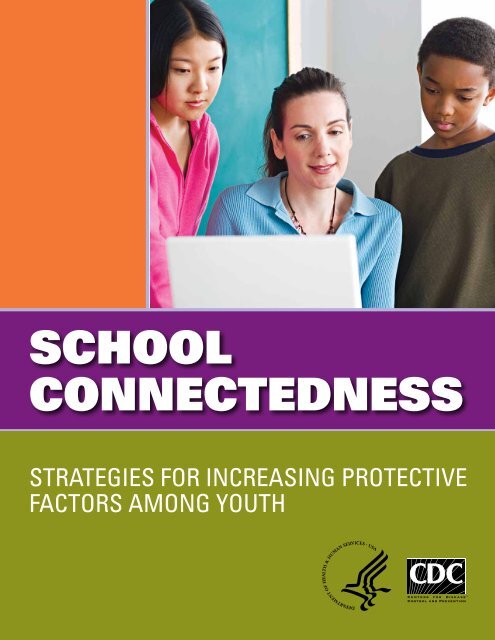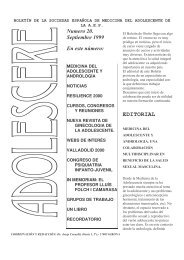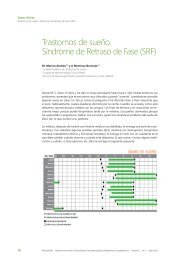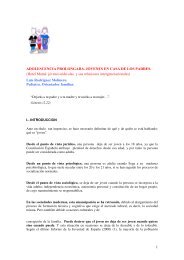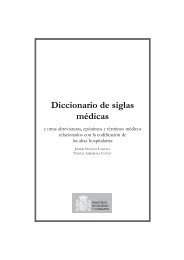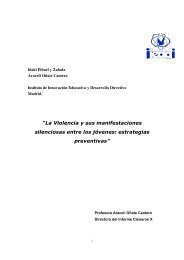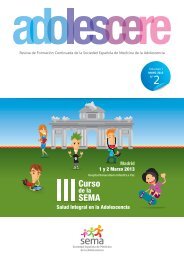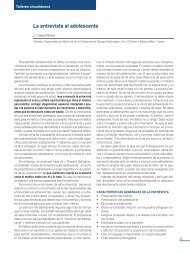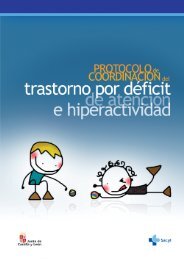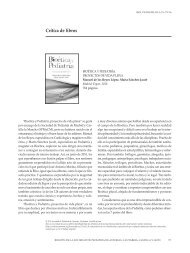School Connectedness: Strategies for Increasing Protective Factors ...
School Connectedness: Strategies for Increasing Protective Factors ...
School Connectedness: Strategies for Increasing Protective Factors ...
Create successful ePaper yourself
Turn your PDF publications into a flip-book with our unique Google optimized e-Paper software.
Families, schools, and communitiesall need to work together to createan environment that facilitateshealthy development of childrenand adolescents.2
Adult SupportAccording to research by Blum and colleagues, childrenand adolescents’ beliefs about themselves and their abilitiesare shaped by the extent to which they perceive that theadults in their lives care about them and are involvedin their lives. 3 Children and adolescents who feel supportedby important adults in their lives are likely to be moreengaged in school and learning. 15 In the school setting,students feel supported and cared <strong>for</strong> when they see schoolstaff dedicating their time, interest, attention, and emotionalsupport to them. 16 Students need to feel that adults careabout them as individuals as well as about their academicachievement. 2 Smaller schools may encourage morepersonal relationships among students and staff and allow<strong>for</strong> personalized learning. 17–19 <strong>School</strong>s can <strong>for</strong>m schoolswithin-a-schoolor create multidisciplinary teams of teachersin which a small number of teachers know each student andcan ensure that every student has an identified advisor. 20Belonging to a Positive Peer GroupStudents’ health and educational outcomes are influencedby the characteristics of their peers, such as how sociallycompetent peer group members are or whether the peergroup supports pro-social behavior (e.g., engagingin school activities, completing homework assignments,helping others). 21 Being part of a stable peer networkprotects students from being victimized or bullied. 22However, if the norms in the peer group support sociallyirresponsible behavior (e.g., bullying, graffiti), students areless likely to be involved in school activities, and their senseof connectedness to school, achievement levels, and healthbehaviors can suffer. 21,22Strong interpersonal skills enable students to maintainhealthy relationships. Students who report feeling mostconnected to school also report having the most friendsat school and having friends from several different socialgroups that are integrated by race and gender. Conversely,those students who report feeling less connected to schoolhave more friends from outside school than inside or aresocially isolated, reporting few friends either insideor outside of school. 36
Commitment to EducationIt is important that both students and adults are committedto learning and are involved in school activities. Students’dedication to their own education is associated with thedegree to which they perceive that their peers andimportant adults in their lives 1) believe school is importantand 2) act on those beliefs. 23 Students who are personallyinvested in school and believe that a good educationis important <strong>for</strong> reaching their life goals spend more time onhomework and in school activities and have an increasedsense of connectedness to school. 3,18,21,24,25 Students whoare engaged in their own education exhibit behavioral traitssuch as persistence, ef<strong>for</strong>t, sustained attention to tasks, anda higher level of preference <strong>for</strong> challenge and mastery. 16<strong>School</strong> staff who are dedicated to the education of theirstudents build school communities that allow studentsto develop emotionally, socially, and mentally, as wellas academically. Committed adults engage studentsin learning, foster mutual respect and caring, and meet thepersonal learning needs of each student. 3,15,18<strong>School</strong> Environment<strong>Connectedness</strong> is enhanced by a healthy and safe schoolenvironment and a supportive psychosocial climate. A cleanand pleasant physical environment (e.g., one free fromgraffiti) raises expectations <strong>for</strong> safety and sets the stage <strong>for</strong>positive, respectful relationships. 26The psychosocial climate at school is influenced by suchfactors as policies related to discipline, opportunities <strong>for</strong>meaningful student participation, and teachers’ classroommanagement practices. Research indicates that in schoolswith a harsh and punitive discipline climate, studentconnectedness is lower. 3,18 A positive school environment,often called school climate, is characterized by caringand supportive interpersonal relationships; opportunitiesto participate in school activities and decision-making; andshared positive norms, goals, and values. 27,28 One studyfound that schools with a higher average sense-of-communityscore (i.e., composite of students’ perception of caring andsupportive interpersonal relationships and their abilityto be autonomous and have influence in the classroom) hadsignificantly lower average student drug use and delinquency.27,28In addition, schools that have higher rates of participationin extracurricular activities during or after school tendto have higher levels of school connectedness. 3Good classroom management-—including having setroutines and guidelines, adequate planning, and fairconsequences <strong>for</strong> misbehaviors-—is critical to establishing apositive school environment and increasing school connectedness.When classrooms are well managed, relationshipsamong students and between teachers and students tendto be more positive, and students are more engagedin learning and in completing homework assignments. 3Teachers who promote mutual respect in the classroomfoster a sense of safety and connectedness by reducing thethreat of being embarrassed or teased. 29 7
How Can <strong>School</strong>s Influence <strong>Factors</strong> ThatIncrease <strong>School</strong> <strong>Connectedness</strong>?This publication identifies six strategies to increase theextent to which students feel connected to school. Thesestrategies can enhance each of the four factors that influenceschool connectedness (adult support, belonging to positivepeer groups, commitment to education, and school environment).This section describes the strategies, and specificactions under each strategy, that teachers, administrators,other school staff, and parents can implement to enhanceschool connectedness.Improving students’ health and education outcomes byimproving connectedness to school is a large undertakingthat requires ef<strong>for</strong>ts of not only those within school buildingsbut also people and organizations outside of schools.For example, parents and community organizations canprovide support outside of school to enhance activities donewithin the school, and teacher preparation programs andprofessional organizations can provide teachers and schooladministrators with the awareness, knowledge, and skillsneeded to implement the recommended actions. Theseef<strong>for</strong>ts to enhance student connectedness to school alignwell with the Coordinated <strong>School</strong> Health approach promotedby CDC as well as educational re<strong>for</strong>m ef<strong>for</strong>ts, whichin part aim to improve the psychosocial environment ofschools.The strategies and action steps that follow are not listed inorder of priority and are not intended to be exhaustive lists.Some of the actions are small changes in school processesthat can be done in the short term with relative ease,whereas others might be much broader, longer-term goalsthat require administrative or budgetary changes. Individualschools and school districts should determine which actionsare most feasible and appropriate, based on the needsof the school and available resources. Implementation willrequire a team ef<strong>for</strong>t that involves school administrators,teachers, other staff, students, families, and communities.It is important to secure buy-in from these groups and toteach them about the importance of school connectedness inimproving students’ health and education outcomes. It alsois important to evaluate ef<strong>for</strong>ts to increase school connectednessto learn which actions have the greatest impact.8
Promoting <strong>School</strong> <strong>Connectedness</strong><strong>Strategies</strong> to Increase <strong>School</strong> <strong>Connectedness</strong>1. Create decision-making processes that facilitate student, family, and communityengagement; academic achievement; and staff empowerment.2. Provide education and opportunities to enable families to be actively involvedin their children’s academic and school life.3. Provide students with the academic, emotional, and social skills necessaryto be actively engaged in school.4. Use effective classroom management and teaching methods to fostera positive learning environment.5. Provide professional development and support <strong>for</strong> teachers and other schoolstaff to enable them to meet the diverse cognitive, emotional, and social needsof children and adolescents.6. Create trusting and caring relationships that promote open communicationamong administrators, teachers, staff, students, families, and communities.Adult SupportBelongingto aPositive PeerGroupCommitmentto Education<strong>School</strong>Environment<strong>School</strong><strong>Connectedness</strong>PositiveEducationalOutcomesPositiveHealthOutcomes9
Six <strong>Strategies</strong> to Promote <strong>School</strong> <strong>Connectedness</strong><strong>School</strong> administrators, teachers, and other school staff can use the following six strategies and the supporting actionsteps to increase school connectedness:1. Create decision-making processes that facilitate student, family, and community engagement;academic achievement; and staff empowerment.a. Lead the school community in a process to developa shared vision of high standards <strong>for</strong> learning andbehavior. 30,31b. Solicit teacher and staff input and involvement in allef<strong>for</strong>ts to improve the school climate and students’sense of connectedness to school. 32c. Engage students, parents, school staff, and communitymembers in teams to develop school policiesand plan school-wide activities. These teams canalso assist in writing proposals <strong>for</strong> grants and solicitsupport and supplies from local businesses. 33d. Give teachers and principals appropriate decisionmakingauthority over how school resources areused, including people, time, facilities, and funds. 34e. Work with students, faculty, staff, and parentsto identify simple changes or modifications thatwould make the school’s physical environment morepleasant. 3 f.g.h.Assign students developmentally appropriate levelsof responsibility <strong>for</strong> classroom decision-making andmanagement. 35,36Empower students to communicate openly withschool staff and parents by providing a mechanism<strong>for</strong> students to give in-depth evaluations of theirteachers, and hold student-led parent-teacherconferences to actively involve students in thediscussions. 34Engage community partners to provide a rangeof services at the school that students and theirfamilies need (e.g., dental services, healthscreenings, child care, substance abusetreatment). 3710
2. Provide education and opportunities to enable families to be actively involved in theirchildren’s academic and school life.a. Provide opportunities <strong>for</strong> parents to increase theirown skills and competence in areas that will helpthem be more involved in their children’s school life.Opportunities could include educational coursessuch as General Education Development (GED),English as a second language, and effectivecommunication and leadership skills. 38b. Implement training workshops that provide parentswith skills to better manage their children’s behavior.Skills can include identifying desirable andundesirable behaviors, communication strategies,conflict resolution, listening skills, setting expectations<strong>for</strong> behaviors, and appropriate praise. Parentsalso can learn about how to teach their childrenself-restraint and problem-solving. 25,39–42c. Provide parent workshops that teach academicsupport skills, such as how to talk with teachersabout ways parents can help their children developacademic skills. 25,39,40,43,44d. Seek alternative ways to provide hard-to-reachparents with skills training, such as by usinga telephone-based parent education program. 45e. Communicate the school’s behavioral and academicexpectations to families, and encourage them torein<strong>for</strong>ce those expectations at home. Expectationscan be communicated through newsletters, parent–teacher–studentconferences, and school Websites. 44,46f. Encourage parents to create a supportive learningenvironment in the home. This includes providinghomework guidance, ensuring adequate educationalsupplies such as computers or books, and assistingtheir children with time management. 25,39,43,44g. Create a mechanism to strengthen family involvementin student achievement. This could includecreating a full-time staff position to coordinateschool-wide activities and parent involvementor assigning school staff members to be liaisonsto specific students and their families. The school–family liaison can work with the family to identifyways to be involved in the classroom and school;organize meetings with the family and relevant staffto discuss student progress and other issues; ensurethat the student and family feel welcome in theschool; help set academic and behavioral goals;and connect the student and family with communityresources. 39,46,47h. Establish regular meetings with parents to discusstheir children’s behavior, grades, and accomplishments.These could include home visits, which areespecially beneficial during key transition times(i.e., elementary to middle school, middle to highschool, and high school to college/career). 42,46i. Have the first communication from the teacherto the parent be about a positive experience thestudent has had, not a negative one. 48j. Offer multiple opportunities <strong>for</strong> parents to beinvolved in meaningful school and classroomactivities that can fit diverse schedules, skills,and abilities. Examples include assisting in theclassroom, attending after-school events,collaborating on homework activities, participatingin a school health team or parent organization,and assisting with linking community resources27,41, 49–54to the school.k. Reduce barriers to parent involvement by providingservices such as babysitting, transportation, andalternate meeting locations. 55l. Create opportunities and mechanisms <strong>for</strong> parentsto share important aspects of their culture, needs,and expectations <strong>for</strong> their children. 56m. Translate materials into languages spoken mostcommonly in students’ homes. Provide bilingualinterpreters to assist non-English-speaking familiesat school events. 56 11
3. Provide students with the academic, emotional, and social skills necessary to be activelyengaged in school.a. Implement tutoring programs to provide one-on-oneassistance to students. Tutors can provide weeklyacademic help in reading and math, help studentswith decision-making, and work with students todevelop specific academic and social goals. 16,42,51,52b. Support positive academic competition within andamong schools. 57 For example, schools can establishinterscholastic team competitions in academicsubjects and offer activities such as debate andphysics projects.c. Offer extended learning opportunities <strong>for</strong> allstudents, such as summer and vacation camps,to improve academic and social skills. 39,43,51d. Provide opportunities <strong>for</strong> students to improve theirinterpersonal skills, such as problem-solving, conflictresolution, self-control, communication, negotiation,sharing, and good manners. Other skills that couldbe taught include listening, stress management, anddecision making. 25,39,41,44,58,59g. Correct inaccurate perceptions about what arenormal behaviors among students (e.g., how manystudents smoke or drink alcohol). 44h. Use incidents in the classroom as “teachablemoments” to educate students on self-control, empathy,cooperation, and conflict resolution skills. 35i. Provide opportunities throughout the school daythat allow students to identify and label their feelings,express their feelings, and assess the intensityof their feelings. 36,49j. Engage students in planning <strong>for</strong> their future,including career and personal goals. Assist themin mapping out steps to take to meet their goals. 40,62k. Use school sporting events and physical educationclasses to promote teamwork and sportsmanshipand emphasize fair play and nonviolence. 26,63e. Foster pro-social behavior by engaging studentsin helping activities such as service learning,peer tutoring, classroom chores, and teacherassistance. 60 Use classroom activities and lessonsto explore and discuss empathy, personal strengths,fairness, kindness, and social responsibility. 40,49f. Teach refusal and resistance skills, including howto recognize social influences to engage in problembehaviors, identify consequences of problem behaviors,generate and suggest alternatives, and invitepeers to join in those alternative activities. 39,43,59,6112
4. Use effective classroom management and teaching methods to foster a positive learningenvironment.a. Communicate clear expectations <strong>for</strong> learningand behavior. 39,43,64 Ensure that expectations aredevelopmentally appropriate and that all studentsare held to the same expectations.b. Ensure that lessons are linked to standards and aresequential to ensure that students’ learning buildsupon prior lessons. 34,46,65c. Clearly describe lesson goals and how the in<strong>for</strong>mationrelates to students and the real world. 9,35,66d. Assess students continuously and use the resultsto guide the direction of the class and teachingmethods used. 16,34,46e. Use interactive and experiential activities, suchas group discussions, problem solving, and roleplaying, to engage students in learning and helpthem personalize the in<strong>for</strong>mation. 9,35,36,66,67f. Be flexible with instructional strategies to allow<strong>for</strong> teachable moments and personalization of theacademic lessons. 30g. Use a variety of teaching methods such as discussionquestions, extra readings, and group projectsto foster critical and reflective thinking, problemsolvingskills, and the capacity to work effectivelywith others. 67h. Apply a variety of classroom management strategiesand teaching methods that are conduciveto the diverse needs and learning styles of students.Examples of strategies include assessing studentknowledge be<strong>for</strong>e teaching, teaching to explicitlearning objectives, involving students in smallcooperative learning groups, and organizing andstructuring the classroom in ways that preventdiscipline problems from occurring. 16,39,43,44,60,68 i.j.k.l.m.Engage students in appropriate leadership positionsin the classroom and provide avenues <strong>for</strong> theirvoices and opinions to be heard. For example,include students in the decision-making process <strong>for</strong>setting classroom rules and consequences <strong>for</strong> breakingthe rules. 44,49,67,69Establish a reward system <strong>for</strong> both academic andextracurricular achievements, such as writtenpraise or coupons to purchase items in the schoolstore. 39,43,44 In addition, encourage the intrinsicrewards of learning by displaying student workand accomplishments to parents, other students andteachers, and members of the community. 67Provide diverse opportunities <strong>for</strong> students to bemeaningfully involved, learn, and be recognized.These opportunities could include service learning,extracurricular activities, and creative projects. 9,30,46For example, integrate academic programs withcommunity service (e.g., developing writing skillsby working on a community newspaper, rein<strong>for</strong>cingmath skills by tutoring younger students). 16,52Encourage open, respectful communication aboutdiffering viewpoints. Creating opportunities <strong>for</strong>students to challenge and debate can teach respect<strong>for</strong> diverse opinions and perspectives. 49,67Reduce class size to ensure more time <strong>for</strong> individualizedassistance. 34,70 13
5. Provide professional development and support <strong>for</strong> teachers and other school staff to enablethem to meet the diverse cognitive, emotional, and social needs of children and adolescents.a. Employ teachers who have been trained in childdevelopment, and demonstrate effective implementationof student-centered pedagogy, a varietyof classroom management techniques, and teachingmethods (e.g., cooperative learning). 16b. Offer professional development on ways toorganize and structure the classroom to promotea positive environment. Developmentally appropriatediscipline strategies emphasize positive behaviorsand values and assist students in developingself-control. 49c. Educate school staff on strategies to effectivelyinvolve parents in their children’s school life. Importantskills include how to establish regular communication,communicate effectively with parents fromdiverse cultures, conduct effective parent–teacher–student conferences, involve parents in homeworkassignments, and organize classroom events thatengage parents. 46d. Provide training on all curricula the school plansto use, as well as effective teaching methods (e.g.,cooperative learning, active learning), to maximizethe curricula’s effectiveness. Ensure that teachershave the necessary materials, time, resources, andsupport to effectively use the skills learned in training.36,40,44,49e. Enable teachers to learn from each other by buildinglearning teams to observe experienced teachersapplying effective classroom management techniquesand facilitating group work in a way thatvalues students’ thoughts and opinions. 46f. Develop a coaching or mentoring program <strong>for</strong>teachers. Pairing teachers in this manner allowsthem to solve problems at school, share teachingtechniques and classroom management strategies,and create a supportive work environment. 39,43,44,4914
6. Create trusting and caring relationships that promote open communication amongadministrators, teachers, staff, students, families, and communities.a. Consider structuring the school so that teachers staywith the same students <strong>for</strong> 3 years in elementaryand middle school and 2 or more years in highschool. 34 This can provide better continuity in learningand might allow the development of strongerteacher–student relationships. 16b. Allow students and their parents to use the schoolbuilding and property outside of school hours<strong>for</strong> recreational or health promotion programs. 71This can increase their feeling of being part of theschool community.c. Apply reasonable and consistent disciplinarypolicies that are collectively agreed upon bystudents and staff and are fairly en<strong>for</strong>ced. 67,72d. Hold school-wide activities that give studentsopportunities to learn about different cultures,people with disabilities, and topics such as artsor sports. This will increase students’ respect <strong>for</strong>diversity and <strong>for</strong>m connections among students. 35<strong>Increasing</strong> understanding of similarities and differencescan engender respect.e. Provide opportunities <strong>for</strong> students of all achievementlevels to interact with one another and developfriendships, promote teamwork, and lessenhierarchical divisions between older and youngerstudents. 9,16,35g. Have principals, teachers, and other school staffcommit to and model respectful behavior towardeach other. 36,58,59h. Challenge staff to greet each student by name. 46i. Encourage school staff to make a concerted ef<strong>for</strong>tto reach out to students who may be experiencingacademic or social issues and get to know them,opening up the possibility <strong>for</strong> stronger relationshipswith those students. 32j. Ensure that school staff members have an expert(e.g., school counselor, school psychologist) theycan consult with about student issues they feel arebeyond their expertise, and to whom they can referstudents who need assistance they are not qualifiedto provide. 16,34k. Use a variety of methods to communicate and promoteexpectations, values, and group norms thatsupport positive health and academic behaviors.Communications can be addressed to students,school staff, families, and members of the communitythrough a variety of channels such as schoolassemblies, newsletters, or a school Web site. 49,60 15f. Create opportunities <strong>for</strong> students to work in partnershipwith adults in helping roles. For example, servicelearning opportunities enable students to connectwith adults in the community (e.g., field trips,community volunteer events, internships). 60 Involvestudents in activities that traditionally involved onlyadults (e.g., parent–teacher conferences, curriculumselection committees, school health teams). 33,40,67
ConclusionChildren and adolescents are establishing patterns ofbehavior and making lifestyle choices that affect both theircurrent and future health. Families, schools, and communitiesall need to work together to create an environment thatfacilitates healthy development of children and adolescents.Research has shown that students who feel more connectedto school are more likely to have positive health and educationoutcomes. The six strategies outlined in this publicationprovide a framework <strong>for</strong> increasing students’ connectednessto school. In combination with evidence-based healthpromotion programs, strategies such as these can helpschools have the greatest impact on the health andeducation outcomes of their students.16
AcknowledgmentsThis publication was developed by the Centers <strong>for</strong> DiseaseControl and Prevention’s (CDC) Division of Adolescent and<strong>School</strong> Health (DASH) with consultation from Robert BlumMD, PhD, the William H. Gates Sr. Professor and Chair,Department of Population and Family Health Sciences, JohnsHopkins Bloomberg <strong>School</strong> of Public Health, and Dana CarrMPH, at the U.S. Department of Education, Office of Safeand Drug-Free <strong>School</strong>s.“American teens can have strongerhealth and educational outcomes.<strong>Increasing</strong> school connectednesscan make it happen.”Robert Blum MD, PhD17
References1. Kipke M, ed. Risks and Opportunities: Synthesis of Studieson Adolescence. Washington, DC: National Academies Press;1999.2. Resnick MD, Bearman PS, Blum RW, et al. Protecting adolescentsfrom harm. Findings from the National LongitudinalStudy on Adolescent Health. JAMA 1997;278(10):823–832.3. Blum RW, McNeely C, Rinehart PM. Improving the odds: theuntapped power of schools to improve the health of teens.Minneapolis: Center <strong>for</strong> Adolescent Health and Development,University of Minnesota; 2002.4. Wingspread declaration on school connections. Journalof <strong>School</strong> Health 2004 2004;74(7):233–234.5. Resnick MD. Close ties to parents, school improve adolescents’lives. Minnesota Medicine 1997;80(12):24–26.6. Resnick MD, Harris LJ, Blum RW. The impact of caring andconnectedness on adolescent health and well-being. Journalof Paediatrics & Child Health 1993;29(Suppl 1):S3–9.7. Nonnemaker J, McNeely C, Blum R. Public and privatedomains of religiosity and adolescent health risk behaviors:Evidence from the National Longitudinal Study of AdolescentHealth. Social Science & Medicine 2003;57:2049–2054.8. McNeely C. Connections to school as an indicator of positivedevelopment. Paper presented at the Indicators of PositiveDevelopment Conference, Washington, DC; 2003.9. Klem AM, Connell JP. Relationships matter: linking teachersupport to student engagement and achievement. Journalof <strong>School</strong> Health 2004;74(7):262–273.10. Rosenfeld LB, Richman JM, Bowen GL. Low socialsupport among at-risk adolescents. Social Work in Education1998;20:245–260.11. Battin-Pearson S, Newcomb MD, Abbot RD, Hill KG, CatalanoRF, Hawkins JD. Predictors of early high school dropout:a test of five theories. Journal of Educational Psychology2000;92(3):568–582.12. Barber BK, Olsen JA. Socialization in context: connection,regulation, and autonomy in the family, school andneighborhood, and with peers. Journal of AdolescentResearch 1997;12(2):287–315.13. Hawkins JD. Academic per<strong>for</strong>mance and school success:sources and consequences. In: Weissberg RP, Gullotta TP,Hampton RL, Ryan BA, Adams GR, eds. Healthy Children2010: Enhancing Children’s Wellness.Vol 8. Issues in Children’sand Families’ Lives. Thousand Oaks, CA: Sage; 1997.14. Centers <strong>for</strong> Disease Control and Prevention. Fact sheet:Health risk behaviors and academic achievement; Atlanta:U.S. Department of Health and Human Services; 2008.15. Croninger RG, Lee VE. Social capital and dropping out of highschool: benefits to at-risk students of teachers’ support andguidance. Teachers College Record 2001;103(4):548–581.16. National Research Council and the Institute of Medicine.Engaging <strong>School</strong>s: Fostering High <strong>School</strong> Students’Motivation to Learn. Washington, DC: National AcademiesPress; 2004.17. Cohen G, Miller C, Stonehill R, Geddes C. The Class-SizeReduction Program: Boosting Student Achievementin <strong>School</strong>s Across the Nation. Jessup, MD: U.S. Departmentof Education; September 2000.18. McNeely CA, Nonnemaker JM, Blum RW. Promoting schoolconnectedness: evidence from the National LongitudinalStudy of Adolescent Health. Journal of <strong>School</strong> Health2002;72(4):136–146.19. Lee V, Smith J. Effects of high school restructuring and sizeon early gains in achievement and engagement. Sociologyof Education 1995;68:241–270.20. Blum R. <strong>School</strong> <strong>Connectedness</strong>: Improving the Livesof Students. Baltimore: Johns Hopkins Bloomberg <strong>School</strong>of Public Health; 2005.21. Furlong MJ, Whipple AD, St. Jean G, Simental J, Soliz A,Punthuna S. Multiple contexts of social engagement: movingtoward a unifying framework <strong>for</strong> educational research andpractice. Cali<strong>for</strong>nia <strong>School</strong> Psychologist 2003;8:99–113.22. Pellegrini A, Bartini M. A longitudinal study of bullying, victimization,and peer affiliation during the transition from primaryschool to middle school. American Educational ResearchJournal 2000;37(3):699–725.23. Libbey HP. Measuring student relationships to school: attachment,bonding, connectedness, and engagement. Journalof <strong>School</strong> Health 2004;74(7):274–283.24. Maddox SM, Prinz RJ. <strong>School</strong> bonding in children andadolescents: conceptualization, assessment, and associatedvariables. Clinical Child and Family Psychology Review2003;6(1):31–49.25. Hawkins JD, Guo J, Hill KG, Battin-Pearson S, Abbott RD.Long-term effects of the Seattle Social Development interventionson school bonding trajectories. Applied DevelopmentalScience 2001;5(4):225–236.26. Centers <strong>for</strong> Disease Control and Prevention. <strong>School</strong> healthguidelines to prevent unintentional injuries and violence.MMWR 2001;50(RR-22):1–73.27. Battistich V, Hom A. The relationship between students’sense of their school as a community and their involvementin problem behaviors. American Journal of Public Health1997;87(12):1997–2001.28. Wilson D. The interface of school climate and school connectednessand relationships with aggression and victimization.Journal of <strong>School</strong> Health 2004;74(7):293–299.29. Ryan AM, Patrick H. The classroom social environment andchanges in adolescents’ motivation and engagement duringmiddle school. American Educational Research Journal2001;38(2):437–460.30. Legters N, Balfanz R, McPartland J. Solutions <strong>for</strong> FailingHigh <strong>School</strong>s: Converging Visions and Promising Models.Washington, DC: U.S. Department of Education; 2002.31. Owings WA, Kaplan LS, eds. Best Practices, Best Thinking,and Emerging Issues in <strong>School</strong> Leadership. Thousand Oaks,CA: Corwin Press; 2003.18
32. Education Development Center. <strong>School</strong> connectedness andmeaningful student participation. Washington, DC: U.S.Department of Education; 2008: Available at http://www.ed.gov/admins/lead/safety/training/connect/index.html.33. Hawkins JD, Von Cleve E, Catalano RF. Reducing early childhoodaggression: results from a primary prevention program.Journal of the American Academy of Child and AdolescentPsychiatry 1991;30(2):208–217.34. Gambone MA, Klem AM, Summers JA, Akey TM, Sipe CL.Turning the Tide: the Achievements of the First Things FirstEducation Re<strong>for</strong>m in the Kansas City, Kansas Public <strong>School</strong>District. Philadelphia: Youth Development <strong>Strategies</strong>, Inc.;2004.35. Battistich V, Schaps E, Watson MS, Solomon D. Preventioneffects of the Child Development Project: early findings froman ongoing multisite demonstration trial. Journal of AdolescentResearch 1996;11(1):12–35.36. Greenberg MT, Kusche CA, Cook ET, Quamma JP. Promotingemotional competence in school-aged children: the effectsof the PATHS curriculum. Development and Psychopathology1995;7:117–136.37. Dryfoos J. Full-Service <strong>School</strong>s: A Revolution in Healthand Social Services <strong>for</strong> Children,Youth, and Families.San Francisco: Jossey-Bass Publishers; 1994.38. Henderson AT, Mapp KL. A New Wave of Evidence.TheImpact of <strong>School</strong>, Family, and Community Connectionson Student Achievement. Austin, TX: Southwest EducationalDevelopment Laboratory; 2002.39. Catalano RF, Haggerty KP, Oesterle S, Fleming CB, HawkinsJD. The importance of bonding to school <strong>for</strong> healthy development:findings from the Social Development Research Group.Journal of <strong>School</strong> Health 2004;74(7):252–261.40. Flay BR, Allred CG. Long-term effects of the PositiveAction Program. American Journal of Health Behavior2003;27(1):S6–S21.41. Perry CL, Williams CL, Veblen-Mortenson S, et al. ProjectNorthland: Outcomes of a communitywide alcohol useprevention program during early adolescence. AmericanJournal of Public Health 1996;86(1):956–965.42. Conduct Problems Prevention Research Group. The effectsof the Fast Track program on serious problem outcomesat the end of elementary school. Journal of Clinical Child andAdolescent Psychology 2004;33(4):650–661.43. Lonczak HS, Abbott RD, Hawkins JD, Kosterman R, CatalanoRF. Effects of the Seattle Social Development Project onsexual behavior, pregnancy, birth, and sexually transmitteddisease outcomes by age 21 years. Archives of Pediatrics& Adolescent Medicine 2002;159(3):270–277.44. Hawkins JD, Catalano RF, Morrison DM, O’Donnell J, AbbottRD, Day LE. The Seattle Social Development Project: Effectsof the First Four Years on <strong>Protective</strong> <strong>Factors</strong> and ProblemBehaviors. New York/London: The Guil<strong>for</strong>d Press; 1992.45. Borowsky I, Mozayeny S, Stuenkel K, Ireland M. Effectsof a primary care-based intervention on violent behavior andinjury in children. Pediatrics 2004;114(4):e392–e399.46. Quint J, Bloom HS, Black AR, Stephens L, Akey TM. TheChallenge of Scaling Up Educational Re<strong>for</strong>m. Findings andLessons from First Things First. New York: MDRC; 2005.47. Hoover-Dempsey KV, Sandler HM. Why do parents becomeinvolved in their children’s education? Review of EducationalResearch 1997;67(1):3–42.48. Izzo CV, Weissberg RP, Kasprow WJ, Fendrich M. A longitudinalassessment of teacher perceptions of parent involvementin children’s education and school per<strong>for</strong>mance. AmericanJournal of Community Psychology 1999;27(6):817–839.49. Battistich V, Solomon D, Watson MS, Solomon J, Schaps E.Effects of an elementary school program to enhance prosocialbehavior on children’s cognitive-social problem-solving skillsand strategies. Journal of Applied Developmental Psychology1989;10:147–169.50. Battistich V, Solomon D, Watson MS, Schaps E. Caring schoolcommunities. Educational Psychologist 1997;32(3):137–151.51. Slavin RE, Madden NA, Dolan LJ, Wasik BA. Success <strong>for</strong> all:a summary of research. Journal of Education <strong>for</strong> StudentsPlaced at Risk 1996;1(1):41–76.52. LoSciuto L, Rajala AK, Townsend TN, Taylor AS. An outcomeevaluation of Across Ages: an intergenerational mentoringapproach to drug prevention. Journal of Adolescent Research1996;11(1):116–129.53. Epstein JL, Sanders MG, Simon BS, Salinas KC, JansormNR, Van Voorhis FL. <strong>School</strong>, Family, and Community Partnerships:Your Handbook <strong>for</strong> Action. Second ed. Thousand Oaks,CA: Corwin Press; 2002.54. Epstein JL. <strong>School</strong>, Family, and Community Partnerships:Preparing Educators and Improving <strong>School</strong>s. Boulder:Westview Press; 2001.55. Balli SJ, Demo DH, Wedman JF. Family involvement withchildren’s homework: an intervention in the middle grades.Family Relations 1998;47(2):149–157.56. Peña DC. Parent involvement: influencing factors and implications.Journal of Educational Research 2000;94(1):42–54.57. Bishop JH, Bishop M, Bishop M, et al. Why we harass nerdsand freaks: a <strong>for</strong>mal theory of student culture and norms.Journal of <strong>School</strong> Health 2004;74(7):235–251.58. Farrell AD, Meyer AL, Dahlberg LL. Richmond youth againstviolence: a school-based program <strong>for</strong> urban adolescents.American Journal of Preventive Medicine 1996;12(5):13–21.59. Johnson K, Bryant D, Strader T, et al. Reducing alcohol andother drug use by strengthening community, family, and youthresiliency. Journal of Adolescent Research 1996;11(1):36–67.60. Solomon D, Watson MS, Delucchi KL, Schaps E, BattistichV. Enhancing children’s prosocial behavior in the classroom.American Educational Research Journal 1988;25(4):527–554.61. Ellickson PL, Bell RM, McGuigan K. Preventing adolescentdrug use: long-term results of a junior high program. AmericanJournal of Public Health 1993;83(6):856–861.62. Clark LF, Miller KS, Nagy SS, et al. Adult identity mentoring:reducing sexual risk <strong>for</strong> African-American seventh gradestudents. Journal of Adolescent Health 2005;37(4):337–337.19
63. National Association <strong>for</strong> Sport and Physical Education. Movinginto the Future: National Standards <strong>for</strong> Physical Education,2nd edition. Reston, VA: National Association <strong>for</strong> Sport andPhysical Education; 2004.64. Hamre BK, Pianta RC. Can instructional and emotionalsupport in the first-grade classroom make a difference<strong>for</strong> children at risk of school failure? Child Development2005;76(5):949–967.65. National Research Council and the Institute of Medicine.Engaging Youth in <strong>School</strong>: Fostering High <strong>School</strong> Student’sMotivation to Learn. Washington, DC: National AcademiesPress; 2004.66. Guthrie JT, Davis MH. Motivating struggling readers in middleschool through an engagement model of classroom practice.Reading & Writing Quarterly 2003;19:59–85.67. Patton G, Bond L, Carlin JB, et al. Promoting social inclusionin schools: a group-randomized trial of effects on studenthealth risk behavior and well-being. American Journalof Public Health 2006;96(9):1582–1587.68. Hawkins JD, Lam T. Teacher Practices, Social Development,and Delinquency. Newbury Park, CA: Sage; 1987.69. Hawkins JD, Weis JG. The Social Development Model:an integrated approach to delinquency prevention. Journalof Primary Prevention 1985;6(2):73–97.70. Raywid M. Small schools: a re<strong>for</strong>m that works. EducationalLeadership 1997;55(4):34–39.71. Evenson K, McGinn A. Availability of school physical activityfacilities to the public in four U.S. communities. AmericanJournal of Health Promotion 2004;18:243–250.72. Voisin D, Salazar L, Crosby R, Diclemente R, Yarber W,Staples-Horne M. Teacher connectedness and health-relatedoutcomes among detained adolescents. Journal of AdolescentHealth 2005;37(4):337.e17–e23.20
For more in<strong>for</strong>mation, please contact the Centers <strong>for</strong> Disease Control and PreventionNational Center <strong>for</strong> HIV/AIDS, Viral Hepatitis, STD, and TB PreventionDivision of Adolescent and <strong>School</strong> Health4770 Bu<strong>for</strong>d Highway NEMail Stop K-29Atlanta, GA 30341-3717Telephone: 800-CDC-INFO (232-4636) • TTY: 888-232-6348Email: cdcinfo@cdc.gov • Web: http://www.cdc.gov/HealthyYouthCS122818


